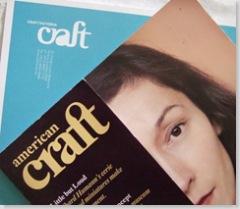What do you think about ‘world craft’? Here’s an opportunity to test your views.
Presented in partnership with the Craft Revival Trust and Craft Australia.
Introduction
The world is becoming ever more inter-connected. Globalisation has led to chains of production that are spread across the world, from textile factories to call centres. And now with campaigns such as ‘We’re in this together’, the issue of climate change has sharpened our awareness that the future our planet is a shared responsibility. The climate change talks in Bali late last year reinforced the need for first and third world to work together. It’s a good opportunity to think about the nature of this cooperation.
A key to recent climate change negotiations has been the recognition of the need for economic development in third world countries. In the crafts, there is already considerable collaboration between first world designers and third world artisans. Such collaboration promises to build trust between the two halves of the world, as well as encourage the development of environmentally-friendly industries .
But trust is a fragile thing. Miscommunication and inappropriate assumptions can lead to suspicion and anger. Greater understanding is required of the interests, hopes and consequences that might be entailed in such collaborations. To develop an understanding of these complexities, a number of hypotheticals will be presented dealing with different kinds of relationships between designers and artisans. Responses are sought from those in the field about the issues evoked. These will form the groundwork for a more extensive study of this activity and the future potential development of a Code of Practice.
Can you sell culture to save culture?
The Ganapi people live in a village in the remote highlands of Gananda, a small tropical nation increasingly dependent on income from its copper mines. Ganapi culture is under great pressure. The male villagers are increasingly drawn to jobs with the mines in a distant province. Local craft traditions are threatened by the influx of cheap commodities. And overall, the Ganapi suffer from a decline in confidence and social cohesion.
A key element of Ganapi culture is the initiation of young men into adulthood. This involves an elaborate and highly secret ritual, during which the men are scarred and adorned with an ornately woven string bag, known as the xanak. This bag is produced during the ceremonies and its design is said to prophesise the future of its owner.
Herbert Downer is an anthropologist who has taken great interest in the Ganapi. He feels it is important to contribute something back to the culture that has helped establish his academic career. An old school friend has established a very successful technology company that markets products to the exclusive global elite. InfoGlobal have developed a device which combines Skype, GPS, MP3 player, language translation, email and news feeds. At the high price of US$1,200, it is designed for a limited market. Research has revealed that their target market is motivated to consume products that have a clear narrative of social responsibility. Elite consumers like to drink fair trade coffee and purchase hand-made goods. But at the same time, they are not averse to cutting edge technology.
Downer proposed that InfoGlobal commission the Ganapi people to design a cover for this new device using a traditional design. The cover would be mass-produced in the China, where the device is manufactured. The final product would be called a Xanak and be sold with a narrative about the cover, explaining the special meaning of the design as a guarantee of the wearer’s safety and success. InfoGlobal are thrilled with the idea and keen for their product designer to visit Ganada to secure the design.
Downer now visits his trusted confidante, Moses Fenami, and presents him with the idea. ‘I have a solution to the troubles now afflicting the village. A friend of mine is keen to buy one of the Xanak designs that are part of the cultural treasures of the Ganapi people. This design will be worn by very important people who travel widely around the world. The Ganapi story will be spread far and wide. Not only that, but the village will also receive a generous fee of $250,000 which will be donated for community projects, including a tourist centre to increase trade and draw people back to the village. I think it’s a golden opportunity to save Ganapi culture. What do you think?’
Moses replies, ‘Dear brother professor Downer. It is very kind that you have sought ways of helping the Ganapi. You are a true brother of the Ganapi. We certainly do need help. Our people have gone crazy with all these new things. Our men go to the copper mines and spend their money on drink and gambling. No one seems to care for the old ways any more. I fear greatly that our children will not know about their ancestors.
‘Perhaps this the way forward. Rather than just keeping our sacred stories and beautiful objects to ourselves, we learn to share them with other people. Other people can then help us re-build our culture.
‘But your solution is worrying too. These designs that you talk about are sacred to us. They are not produced lightly. Usually when everyone knows something in our culture, it is no longer important. We have strict rules. No man can wear another’s xanak. This might break one of the last ties that keep us together. So I’m not sure if the medicine would be worse than the disease. Please give me some time to consult with the other elders before I give you an answer.’
What do you think?
So, if you were a Ganapi elder, how would you advise Moses to answer Professor Downer:
- YES, to seek resources and interest of the modern world to help strengthen Ganapi culture
- NO, to preserve the sacred bed-rock of Ganapi values
Please register your opinion in the poll on this site. If there is more you’d like to add, such as an alternative solution, please leave a comment here.




